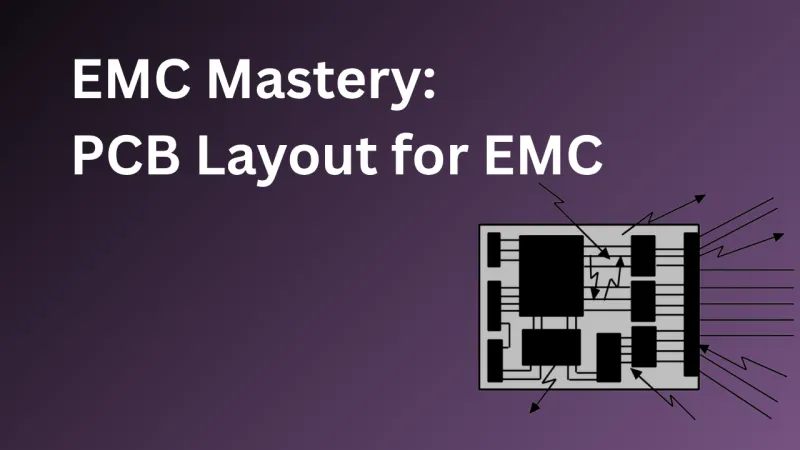

EMC Mastery: PCB Layout for EMC
$600.00
Quantity
Circuit Board Layout to Reduce Electromagnetic Emission and Susceptibility by Dr. Van Doren
Education to Improve Electromagnetic Compatibility and Signal Integrity
Overview
Thanks for your interest in this educational program on "Circuit Board Layout to Reduce Electromagnetic Emission and Susceptibility." Most engineers and technicians designing electronic systems that are fabricated on printed circuit boards have not had any formal training concerning electromagnetic compatibility principles. Learning how to solve routing, grounding, filtering, and shielding problems by trial and error can be very expensive for the employer and frustrating for the designer. Most of the electromagnetic and circuit principles involved are very simple. However, the complexity of many systems masks the logic and simplicity of possible solutions. This workbook is designed to accompany either live or video taped lectures. The workbook greatly reduces the amount of note taking, but still requires your active participation to record key information and to complete the example problems. The objectives of this program are: 1. To base electromagnetic compatibility design decisions on logical engineering principles rather than trial and error; 2. To understand the four noise coupling mechanisms that cause all electrical interference problems; and, 3. To learn how to systematically diagnose and reduce board level electrical interference problems. This course is available for virtual on-demand training. Please contact us if you have any questions about this course.
Program Description
The course covers circuit board layout issues that span the frequency range from DC to several GHz. Mixed analog and digital designs, and multilayer boards are emphasized. Most of the concepts and techniques presented are applicable to one- and two-sided board designs. Several key concepts are illustrated with demonstrations. You will also learn techniques for diagnosing electromagnetic interference problems at the board level. This course shows that the issues of safety, emission, and susceptibility can be used to determine if, where, and how to connect the circuit board to a metal enclosure. Each specific case has its own unique result, but all conclusions are based on the same electromagnetic compatibility principles.
Benefits
This course will help you to: · Design or manufacture electronic equipment · Design printed circuit boards · Design metal enclosures for circuit boards · Select connectors and cables attached to circuit boards · Design integrated circuits and packages · Design filters to reduce conducted emissions · Select heat sinks for integrated circuit packages · Test for electromagnetic compatibility of products containing circuit boards
Learning Objectives
· Explain why wiring inductance is more important than resistance · Describe how current loop area is related to self inductance · Explain how resonances worsen circuit board emission and immunity · Determine which nets should be terminated as transmission lines · Describe the four noise-coupling mechanisms · Describe two ways to reduce each of the four coupling mechanisms · Explain the two reasons for grounding · Explain the difference between a grounding conductor and a signal return conductor · Explain why a signal should be grounded to an external metal enclosure · Explain when to use series blocking and shunt diverting filter techniques · Understand the problem with mutual inductance between the input and output loops of shunt capacitors · Recognize trace layouts that have excessive inductance · Design more effective DC power-distribution busses · Understand the advantages of alternative layer stackup configurations
COURSE INSTRUCTOR
Dr. Tom Van Doren is a professor of Electrical and Computer Engineering at the University of Missouri-Rolla and a member of the Electromagnetic Compatibility Laboratory. Dr. Van Doren has 32 years of teaching and industrial experience in the areas of electromagnetic compatibility, data acquisition, microwave communication systems, and semiconductor device fabrication. Over the past 20 years, more than 17,000 engineers and technicians have attended his short courses on "Grounding and Shielding of Electronic Systems" and "Circuit Board Layout to Reduce Electromagnetic Emission and Susceptibility."
Course Outline
Session 1: 1. Introduction 2. Signal Routing and the Path of Least Impedance 3. Transmission Line Effects Session 2: 3. Transmission Line Effects (cont.) 4. Noise Coupling Mechanisms Session 3: 5. Circuit Board Grounding Issues 6. Filtering Conducted Noise Session 4: 7. DC Power Distribution and Decoupling Session 5: 8. Component Placement and Layer Stackup 9. Chassis, Cable, and System Issues 10. Review of EMC Principles and Board Layout Guidelines APPENDIX 1 A Review of Background Material APPENDIX 2 A Summary of EMC Guidelines for Circuit Board Layout
